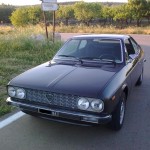
Lancia Beta Coupe
The Beta Coupe was released in 1973, built on a shortened platform of the Sedan version, it immediately shows a modern and pleasant design, a mix of sportiness and elegance, thanks to the design by Piero Castagnero. Engines of the first versions had a DOHC 4-cylinder 1.600 and 1.800cc (109 and 119-hp) with front wheel drive. The interior was characterized by four seats with headrests and in fact many did note that seemed to always have four people on board. Really personal dashboard that also sported an attractive look, as well as a full instrumentation on the dash. Earlier versions had the bottom of the tachometer colored in yellow, while in 1975 there was a slight facelift with minor modifications to the front mask and 1600cc and 2000cc were the two engines available, the latter in addition to the displacement’s badge on the boot lid, is recognized for double-glass covered headlights and the grille with four chrome bars on the bottom. In 1976 the 1.3 83-hp version was presented: front with black mask, back seats without head restraints and black profiles instead of chrome, only without alloy wheels. In 1981 another facelift, the deepest one: larger bumpers, redesigned but banal and certainly less personal interior, but materials were not up to expectations, especially those plastics and textiles. Some versions also appeared with a small black spoiler and side profiles in plastic. Very small, but insignificant changes to the output power. Then, in 1982 came the 2.000 Volumex (with a supercharger), but the Beta Coupe was the next to its end. In 1984 the version called HPE (born in ’74) apart from a few difference in its line, followed the mechanical and aesthetic choices of the other sisters.
Our friend Valerio, who has this beautiful ’77 1.300cc model, the one with the interior that we prefer, tells us something about his coupe:
“My car is a 1977 Lancia Beta Coupe with a 1.3 engine; I bought it on January 2011 in a pitiful state of conservation, also because in its last four years it had been kept outdoor; however, having only 32,000 kilometers, the interior and mechanics were in excellent conditions and so, after a thorough check, I started the restoration work, which lasted approximately one year, in which I always respected the canon of originality, except for a small “cosmetic surgery” I wanted to do by replacing the anonymous external rearview mirrors and the black plastic front grille, with the more flashy ones adopted on the very first series (produced only with 1.6 and 1.8 engines). I have to say that during the process I have not found great difficulty and I have not even spent big money in finding parts, some new and others used, probably because the entire mechanical and most of the body are identical between the Beta Coupe, the HPE and the Spider. At the wheel, the 1.300cc engine, the best DOHC designed by Ing. Lampredi, with its 82 horses, it shows quite lively and with a nice sound especially at low and medium revs, but, without a doubt, 20 extra horses provided by the 1600cc would make the driving experience more enjoyable as a function of the low center of gravity and rather stiff suspension that make the car glued to the asphalt and that give a lot of fun while you’re driving on narrow roads. Consumption is certainly not comparable to those of modern cars but overall is not bad, being in the order of 12-13 km/L, unless you do not press the gas pedal too much. The interiors are well kept and decorated with beautiful emerald velvet seats and door panels in combination with inserts in leather-like brown that, in my case, get along really well to the dark brown body. The instrumentation is certainly complete and worthy of a sporty and classic car like this coupe is and, in addition to the obvious speedometer, tachometer, fuel gauge and warning lights of various kinds, offers real gems sometimes absent even on modern cars, such as the oil pressure indicators and the charge status of the alternator. The ride, while imposing a driving position virtually to the ground, allows the driver to see the nose quite well, but we can’t say the same for the rear end, mainly because of the rear window and the top of the sloping tail.
Finally, allow me a consideration, although this car is not particularly listed on the market, at all the meetings which I attended, it was a one-off and has always received its fair share of compliments in spite of most renowned cars such as the beautiful Alfa Romeo GT, that you always see at least in 2-3 specimens”.








